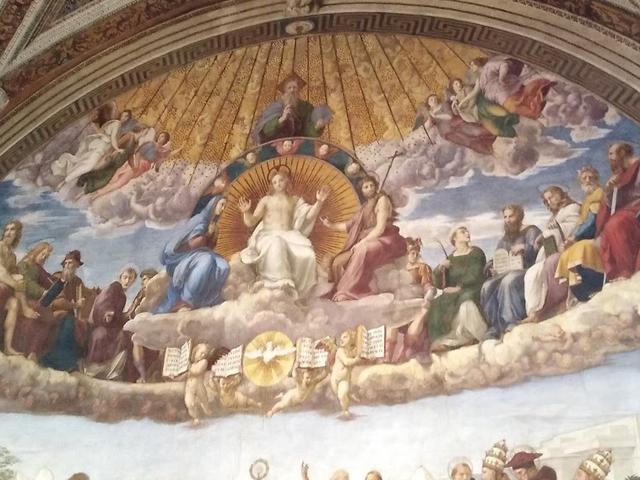Dispute of the Blessed Sacrament

The "Dispute of the Blessed Sacrament" is a renowned fresco painted by the Italian artist Raphael, located in the Vatican City. This masterpiece is part of a series of frescoes that adorn the rooms known as Raphael's Rooms, which were originally commissioned by Pope Julius II in the early 16th century. The title of the fresco was given by the painter Giorgio Vasari, although there has been some controversy surrounding it, with many arguing that it should be called "The Triumph of the Church" instead.
The composition of the fresco is rich in symbolism and religious significance, depicting the theological Truth of the Eucharist in the Christian tradition. In the center of the painting, the Holy Trinity is represented with God the Father, the Christ between the Virgin Mary and Saint John the Baptist, and the Holy Spirit. Surrounding them are various figures representing the Church Triumphant, including patriarchs, prophets, apostles, and martyrs. The Church Militant is also depicted on the ground, with the four Fathers of the Latin Church seated on marble thrones closest to the altar.
Raphael's intention with the "Dispute of the Blessed Sacrament" was to convey the complex theological reality of the Eucharist as a sacramental sacrifice and act of redemption. The fresco serves as a visual representation of the mystery of the Church on earth and in heaven, emphasizing the central role of the Eucharist in Christian worship and belief. The figures in the painting, including historical and religious personalities, are meticulously rendered with attention to detail and expression, adding depth and meaning to the overall composition.
As visitors gaze upon the "Dispute of the Blessed Sacrament," they are invited to contemplate the profound theological truths and spiritual significance embedded in the artwork. The fresco not only showcases Raphael's exceptional talent as a painter but also serves as a powerful testament to the enduring legacy of Renaissance art and religious devotion. It stands as a testament to the enduring power of art to inspire and uplift the soul, making it a must-see attraction for tourists and art enthusiasts visiting the Vatican City.
© ChatGPT 3.5
Next to Bramante appears Francesco Maria della Rovere, who is represented with features similar to those of Leonardo da Vinci.
It was a great challenge for Rafael to paint this work because it was a fresco on a surface that had an unusual shape: the wall is not quadrangular and presents the difficulty of having an arch in the upper area and also that in the lower part the right, a door opened. For this reason, the artist had to paint the fresco on a corbel, with which he would be able to recover the symmetry.
*The Adoration of the Trinity, by Albrecht Dürer, has a composition that is reminiscent of this Dispute of the Sacrament, a work that the artist could not have known, given the date on which it was begun.
*Each character in the work is represented with unique positions, a detail that reveals Rafael's concern for a certain naturalness in his creations.